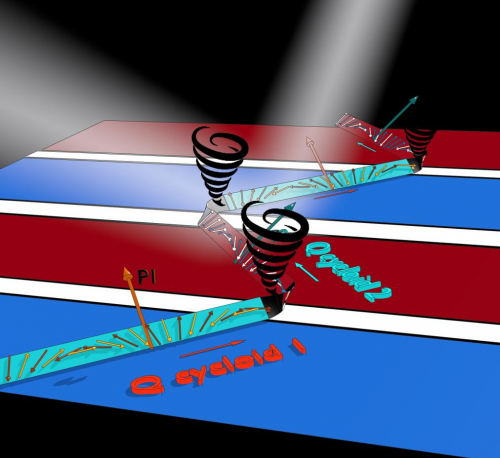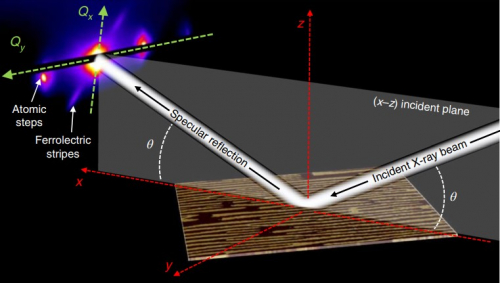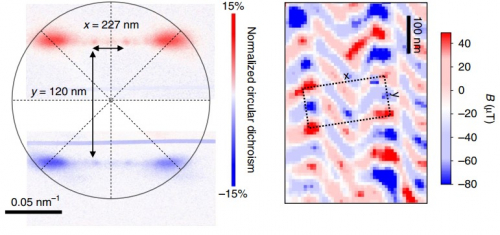A strong collaboration between several groups of Paris-Saclay University namely: the SEXTANTS beamline (SOLEIL synchrotron), the SPEC (UMR3680 CEA-CNRS), the Unité Mixte de Physique CNRS/Thales and the Laboratoire Charles Coulomb (CNRS/Univ. Montpellier), led to substantial breakthroughs in understanding ferroic chiralities in a multiferroic complex* oxide by combining several advanced approaches such as Resonant X-ray scattering (REXS), laboratory imaging techniques (piezoresponse force microscopy and scanning NV magnetometry) and advanced spin dynamics simulations. They have revealed the presence of periodic chiral antiferromagnetic objects as well as chiral electrical winding along the domain walls.

Chirality, a foundational concept throughout science, is the key ingredient of recently discovered magnetic objects named skyrmions. These skyrmions are observed in ferromagnetic materials, where spins of neighbouring atoms tend to align in the same direction. In such skyrmions, the orientation of spins rotates continuously from the up direction at the edge of the circular texture, to the down direction at the centre, or vice versa. The spin’s winding can be either right or left handed, defining their chirality. Theses peculiar topological spin textures are very stable like a knot in a wet rope. They gather multiple assets such as fast dynamics, scalability and low power manipulation; so that they are considered as the future of magnetic data storage. Nevertheless, most of magnetic substances are not ferromagnetic but antiferromagnetic. Louis Néel discovered antiferromagnets and up to now considered as “beautiful and useless” as quoted from his Nobel’s lecture. This might be unfair as antiferromagnets are insensitive to spurious fields and could operate at frequencies 1000 times faster than their ferromagnetic counterpart. Antiferromagnetic chiral textures would then have the final say, paving the way to antiferromagnetic spintronics.
Multiferroics are materials in which several coupled ferroic orders coexist such as antiferromagnetism and ferroelectricity. A magnetoelectric coupling between the two orders leads to the formation of non-collinear spin structures that break space-inversion symmetry and thus allow low power electric-field control of magnetism. BiFeO3 is the archetypal room temperature multiferroic, and the competition between symmetric and asymmetric exchange interactions makes its spins rotate in a chiral magnetic cycloid, being able to propagate in different directions. When several propagation vectors encounter, typically at domain walls, embryos of antiferromagnetic skyrmions are formed. In multiferroic BiFeO3 thin films, a pristine high-density network of ferroelectric stripe domains is imprinted onto the antiferromagnetic order, forcing cycloids with different propagations to stitch in a chiral knot. Several experimental techniques reveal the electric and magnetic order and in particular, REXS (Fig a) enables to access the chirality of these two orders.

Fig a : Principle of the REXS experiment
Dichroic REXS measurements at the oxygen K edge first reveals the chirality of the ferroelectric order thanks to the dichroic contrast inversion. Magnetic x-ray scattering at Fe L edge reveal the presence of two cycloids hosted in each ferroelectric domain, and propagating in alternating directions. These reciprocal space measurements (Fig b - left) are as corroborated by real space scanning NV magnetometry (Fig b - right) and atomic spin simulations. Extra features in the diffracted pattern can be detected thanks to the high photon flux and are originating from periodic chiral antiferromagnetic bubbles formed by the stitching of antiferromagnetic cycloids at ferroelectric domain walls.

Fig b
On the left : Dichroic diffracted pattern at the Fe L edge (inner spots reveal the chiral antiferromagnetic bubbles in the reciprocal space)
On the right : Scanning NV magnetometry (magnetic chiral bubbles popping up every two domain walls in real space)
Hence, both order parameters appear to be chiral and their coupled behavior at domain boundaries call for further work.
In a broader perspective, dichroism in resonant X-ray scattering provides a unique and powerful approach to dig into the physics of chirality and topology of complex ferroic structures (magnetic, electric, multiferroic). Finally, REXS experiments might be extended to time-resolved experiments using a synchrotron or free electron laser, leading to the unprecedented exploration of chiral dynamics.
* Material in which several coupled ferroic orders coexist such as antiferromagnetism and ferroelectricity
Acknowledgements:
European Research Council (ERC-StG-2014, Imagine)
French National Research Agency (ANR) through projects Multidolls, PIAF and SANTA well as the ‘Programme Transversal CEA ACOSPIN and ELSA’
This work was also supported by a public grant overseen by the ANR as part of the ‘Investissement d’Avenir’ programme (LABEX NanoSaclay, ref. ANR-10-LABX-0035)
